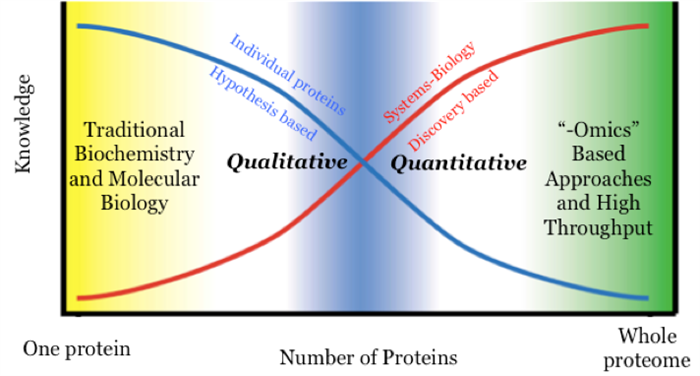The Texas A&M Institute for Preclinical Studies (TIPS) and the Department of Nuclear Engineering at Texas A&M University, under the direction of associate professor Dr. Gamal Akabani, have installed and commissioned a new multimodal Albira Si micro-PET/SPECT/CT system for preclinical small animal imaging. Akabani has been a strong proponent for the establishment of the Small Animal Imaging Core Facility at Texas A&M since his arrival in 2009 and believes the commissioning of this unit is the first step towards establishing what he distinguishes as an essential research core facility.
“With the advent of small animal imaging core facilities across research institutions, the evolution of biomedical research has been transformed from its traditional qualitative, hypothesis-based, single-molecule paradigm to a quantitative, omics systems-based, high throughput paradigm,” Akabani said.

Above:The evolution of protein analysis from traditional biochemistry to unbiased proteomics. Adapted from MacBeath, G. Protein microarrays and proteomics. Nat Genet32 Suppl, 526–532 (2002).
The phenotyping of small animals, mainly rats and mice, using in vivo imaging, is employed across the study of many chronic and degenerative diseases and in drug development: predominantly in the areas of cancer diagnostics and therapeutics. One of the main applications of in vivo imaging is the longitudinal monitoring of treatment response for early indications of efficacy. In vivo small animal imaging has had the greatest impact in drug development through monitoring disease progression and therapeutic response. According to Akabani the process of drug development and research is very competitive with significant failure rates. However, the use of small animal imaging will allow for the fast preclinical testing of early-stage drugs for proof of concept, efficacy and safety without the need to invest significant resources into unnecessary Phase I clinical trails.

Above: The pipeline process of biopharmaceutical research and development. Adapted from Biopharmaceutical research and development : The process behind the medicines. PhRMA, 2015.
The in vivo imaging modalities most currently used are optical (bioluminescence and fluorescence), positron emission tomography, single photon emission computed tomography, x-ray computed tomography (PET/SPECT-CT) and magnetic resonance imaging (MRI). With the acquisition of the Albira micro-PET/SPECT-CT, Akabani and his group hope to provide the faculty and research staff across campus the capacity to longitudinally image the spatiotemporal pathophysiology on animal models using radiolabeled compounds. The Albira Si system is the first generation of micro-PET/SPECT/CT utilizing silicon-based photomultipliers, and new acquisition and reconstruction modules providing great stability and robustness to the system. In collaboration with industrial partner Bruker Biospin Corporation, the Department of Nuclear Engineering plans to continue supporting the mission of TIPS to improve the quality of translational research and preclinical services. The system has been commissioned for imaging with the positron emitting radionuclides 18F, 124I, and 64Cu and, with more to come. The system has also been commissioned for imaging with the single photon emitting radionuclides 99mTc and 123I, which will also be expanded upon. Anatomical co-registration of PET images is carried out using cone beam computed tomography.
Small animal imaging requires the use of positron emitting radionuclide. Whereas some of them are commercially available, some exotic radionuclides are not. Dr. Akabani and his research group have embarked into the production of radionuclides in collaboration with the Texas A&M Cyclotron Institute. Their primary objective is to produce the alpha particle emitting radionuclide 211At, and the other positron emitting radionuclides. Research by his group has focused on the development of binary systems for theranostics. They have a acquired the NIRTA Solid Target system from IBA Radiopharma Solutions (Louvain-La-Neuve, Belgium) and are in the process of commissioning the system in the K150 cyclotron.
TIPS, Akabani, and his research group believe that the system will benefit all researchers across campus using small animals and that the system will have the potential to impact the research of others and meet their small animal imaging research needs.